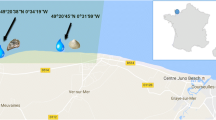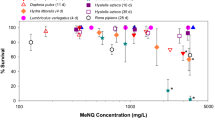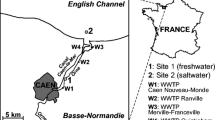Abstract
Pharmaceuticals and other contaminants of emerging concern present unique challenges to environmental risk assessment and management. Fortunately, mammalian pharmacology and toxicology safety data are more readily available for pharmaceuticals than other environmental contaminants. Identifying approaches to read-across such pharmaceutical safety information to non-target species represents a major research need to assess environmental hazards. Here, we tested a biological read-across hypothesis from emergency medicine with common aquatic invertebrate and vertebrate models. In mammals, the antihistamine diphenhydramine (DPH) confers protection from poisoning by acetylcholinesterase inhibition because DPH blocks the acetylcholine receptor. We employed standardized toxicity methods to examine individual and mixture toxicity of DPH and the acetylcholinesterase inhibitor diazinon (DZN) in Daphnia magna (an invertebrate) and Danio rerio (zebrafish, a vertebrate). Though the standardized Fish Embryo Toxicity method evaluates early life stage toxicity of zebrafish (0–3 days post fertilization, dpf), we further evaluated DPH, DZN, and their equipotent mixture during three development stages (0–3, 3–6, 7–10 dpf) in zebrafish embryos. Independent action and concentration addition mixture models and fish plasma modeling were used to assist interpretation of mixture toxicity experiments. Though our primary hypothesis was not confirmed in acute studies with Daphnia magna, DPH conferred a protective effect for acute DZN toxicity to zebrafish when DPH plasma levels were expected to be greater than mammalian therapeutic, but lower than acutely lethal, internal doses. We further observed that timing of developmental exposure influenced the magnitude of DZN and DPH toxicity to zebrafish, which suggests that future zebrafish toxicity studies with pharmaceuticals and pesticides should examine exposure during developmental stages.





Similar content being viewed by others
References
Brooks BW, Huggett DB, Boxall ABA. Pharmaceuticals and personal care products: research needs for the next decade. Environ Toxicol Chem. 2009;28(12):2469–72.
Brooks BW. Fish on Prozac (and Zoloft): ten years later. Aquat Toxicol. 2014;151:61–7.
Ankley GT, Brooks BW, Huggett DB, Sumpter JP. Repeating history: pharmaceuticals in the environment. Environ Sci Technol. 2007;41(24):8211–7.
Boxall ABA, Rudd MA, Brooks BW, Caldwell DJ, Choi K, Hickmann S, et al. Pharmaceuticals and personal care products in the environment: what are the big questions? Environ Health Perspect. 2012;120(9):1221–9.
Seiler JP. Pharmacodynamic activity of drugs and ecotoxicology—can the two be connected? Toxicol Lett. 2002;131(1–2):105–15.
McVey EA. Regulation of pharmaceuticals in the environment: the USA. In: Brooks BW, Hugget D, editors. Human pharmaceuticals in the environment: current and future perspectives. Emerging topics in ecotoxicology: principles, approaches and perspectives. New York: Springer; 2012. p. 49–61.
Laurenson JP, Bloom RA, Page S, Sadrieh N. Ethinyl estradiol and other human pharmaceutical estrogens in the aquatic environment: a review of recent risk assessment data. AAPS J. 2014;16:299–310.
Brooks BW, Huggett DB, Brain RA, Ankley GT. Risk assessment considerations for veterinary medicines in aquatic systems. In: Henderson K, Coats J, editors. Veterinary Pharmaceuticals in the Environment. American Chemical Society Symposium Series. Washington DC: American Chemical Society; 2009. pp. 205–223.
Gunnarsson L, Jauhiainen A, Kristiansson E, Nerman O, Larsson DGJ. Evolutionary conservation of human drug targets in organisms used for environmental risk assessments. Environ Sci Technol. 2008;42(15):5807–13.
Huggett DB, Cook JC, Ericson JF, Williams RT. A theoretical model for utilizing mammalian pharmacology and safety data to prioritize potential impacts of human pharmaceuticals to fish. Hum Ecol Risk Assess. 2003;9(7):1789–99.
LaLone CA, Villeneuve DL, Burgoon LD, Russom CL, Helgen HW, Berninger JP, et al. Molecular target sequence similarity as a basis for species extrapolation to assess the ecological risk of chemicals with known modes of action. Aquat Toxicol. 2013;144–145:141–54.
Berninger JP, Brooks BW. Leveraging mammalian pharmaceutical toxicology and pharmacology data to predict chronic fish responses to pharmaceuticals. Toxicol Lett. 2010;193(1):69–78.
Roos V, Gunnarsson L, Fick J, Larsson DG, Rudén C. Prioritising pharmaceuticals for environmental risk assessment: towards adequate and feasible first-tier selection. Sci Total Environ. 2012;421–422:102–10.
Caldwell DJ, Mastrocco F, Margiotta-Casaluci L, Brooks BW. An integrated approach for prioritizing pharmaceuticals found in the environment for risk assessment, monitoring and advanced research. Chemosphere. 2014;115:4–12.
Connors KA, Du B, Fitzsimmons PN, Hoffman AD, Chambliss CK, Nichols JW, et al. Comparative pharmaceutical metabolism by rainbow trout (Oncorhynchus mykiss) liver S9 fractions. Environ Toxicol Chem. 2013;32(8):1810–8.
Valenti TW, Gould G, Berninger JP, Connors KA, Keele N, Prosser KN, et al. Human therapeutic plasma levels of the selective serotonin reuptake inhibitor (SSRI) sertraline decrease serotonin reuptake transporter binding and shelter-seeking behavior in adult male fathead minnows. Environ Sci Technol. 2012;46:2427–35.
Ankley GT, Bennett RS, Erickson RJ, Hoff DJ, Hornung MW, Johnson RD, et al. Adverse outcome pathways: a conceptual framework to support ecotoxicology research and risk assessment. Environ Toxicol Chem. 2010;29(3):730–41.
Brausch JM, Connors KA, Brooks BW, Rand GM. Human pharmaceuticals in the aquatic environment: a review of recent toxicological studies and considerations for toxicity testing. Rev Environ Contam Toxicol. 2012;218:1–99.
Kolpin DW, Furlong ET, Meyer MT, Thurman EM, Zaugg SD, Barber LB, et al. Pharmaceuticals, hormones, and other organic wastewater contaminants in U.S. streams, 1999–2000: a national reconnaissance. Environ Sci Technol. 2002;36(6):1202–11.
Brooks BW, Riley TM, Taylor RD. Water quality of effluent-dominated ecosystems: ecotoxicological, hydrological, and management considerations. Hydrobiologia. 2006;556(1):365–79.
Backhaus T, Faust M. Predictive environmental risk assessment of chemical mixtures: a conceptual framework. Environ Sci Technol. 2012;46(5):2564–73.
Mohammed FK, Al-Kassim NA, Abdul-Latif AR. Effect of diphenhydramine on organophosphorus insecticide toxicity in mice. Toxicology. 1989;58(1):91–5.
Bird SB, Gaspari RJ, Lee WJ, Dickson EW. Diphenhydramine as a protective agent in a rat model of acute, lethal organophosphate poisoning. Acad Emerg Med. 2002;9(12):1369–72.
Clemmons RM, Meyer DJ, Sundlof SF, Rappaport JJ, Fossler ME, Hubbell J, et al. Correction of organophosphate-induced neuromuscular blockade by diphenhydramine. Am J Vet Res. 1984;45(10):2167–9.
Du B, Perez-Hurtado P, Brooks BW, Chambliss CK. Evaluation of an isotope dilution liquid chromatography tandem mass spectrometry method for pharmaceuticals in fish. J Chromatogr A. 2012;1253:177–83.
Berninger JP, Du B, Connors KA, Eytcheson SA, Kolkmeier MA, Prosser KN, et al. Effects of the antihistamine diphenhydramine on selected aquatic organisms. Environ Toxicol Chem. 2011;30(9):2065–72.
US EPA. Methods for measuring the acute toxicity of effluents and receiving waters to freshwater and marine organisms. Washington, DC: US Environmental Protection Agency; 2002.
American Public Health Association, American Water Works Association, Water Environment Foundation. Standard methods for the examination of water and wastewater. 20th ed. Washington, DC: American Public Health Association; 1998.
U.S. Environmental Protection Agency. 10-day chronic toxicity test using Daphnia magna or Daphnia pulex. Compendium of ERT Standard Operating Protocols, SOP 2028. Edison: Office of Solid Waste and Emergency Response; 1994.
Dzialowski EM, Turner PK, Brooks BW. Physiological and reproductive effects of beta adrenergic receptor antagonists in Daphnia magna. Arch Environ Contam Toxicol. 2006;50(4):503–10.
Hemming JM, Turner PK, Brooks BW, Waller WT, La Point TW. Assessment of toxicity reduction in wastewater effluent flowing through a treatment wetland using Pimephales promelas, Ceriodaphnia dubia, and Vibrio fischeri. Arch Environ Contam Toxicol. 2002;42(1):9–16.
OECD. Test No. 236: Fish Embryo Acute Toxicity (FET) Test. In: OECD Guidelines for the Testing of Chemicals, Section 2: Effects on Biotic Systems; Organisation for Economic Co-operation and Development, Paris, France. doi:10.1787/9789264203709-en.
Kimmel CB, Ballard WW, Kimmel SR, Ullmann B, Schilling TF. Stages of embryonic development of the zebrafish. Dev Dynam. 1995;203(3):253–310.
Faust M, Altenburger R, Backhaus T, Bödeker W, Scholze M, Grimme LH. Predictive assessment of the aquatic toxicity of multiple chemical mixtures. J Environ Qual. 2000;29(4):1063–8.
Overmyer JP, Smith PF, Kellock KA, Kwon J-W, Armbrust KL. Assessment of the toxicological interaction of sertraline with cholinesterase inhibiting insecticides in aquatic insects using the black fly, Simulium vittatum IS-7. Environ Toxicol. 2010;25(1):28–37.
US EPA. Short-term methods for estimating the chronic toxicity of effluents and receiving waters to freshwater organisms. Washington, D.C: Office of Research and Development, US Environmental Protection Agency; 2002.
Zar JH. Biostatistical analysis. 5th ed. Upper Saddle River: Prentice Hall; 2010.
Williams ES, Berninger JP, Brooks BW. Application of chemical toxicity distributions to ecotoxicology data requirements under REACH. Environ Toxicol Chem. 2011;30(8):1943–54.
Brooks BW, Ankley GT, Hobson JF, Lazorchak JM, Meyerhoff RD, Solomon KR. Assessing the aquatic hazards of veterinary medicines. Effects of veterinary medicines in the environment. Boca Raton: CRC; 2008. p. 97–128.
Fernandez-Casalderrey A, Ferrando MD, Andreu-Moliner E. Chronic toxicity of diazinon to Daphnia magna: effects on survival, reproduction and growth. Toxicol Environ Chem. 1995;49(1–2):25–32.
Kretschmann A, Ashauer R, Hitzfeld K, Spaak P, Hollender J, Escher BI. Mechanistic toxicodynamic model for receptor-mediated toxicity of diazoxon, the active metabolite of diazinon, in Daphnia magna. Environ Sci Technol. 2011;45(11):4980–7.
Sánchez M, Ferrando MD, Sancho E, Andreu-Moliner E. Evaluation of a Daphnia magna renewal life-cycle test method with diazinon. J Environ Sci Health A. 1998;33(6):785–97.
Buser CC, Spaak P, Wolinska J. Disease and pollution alter Daphnia taxonomic and clonal structure in experimental assemblages. Freshw Biol. 2012;57(9):1865–74.
Rosi-Marshall EJ. Pharmaceuticals suppress algal growth and microbial respiration and alter bacterial communities in stream biofilms. Ecol Appl. 2013;23(3):583–93.
Meinertz JR, Schreier TM, Bernardy JA, Franz JL. Chronic toxicity of diphenhydramine hydrochloride and erythromycin thiocyanate to Daphnia, Daphnia magna, in a continuous exposure test system. Bull Environ Contam Toxicol. 2010;85(5):447–51.
Backhaus T, Altenburger R, Boedeker W, Faust M, Scholze M, Grimme LH. Predictability of the toxicity of a multiple mixture of dissimilarly acting chemicals to Vibrio fischeri. Environ Toxicol Chem. 2000;19(9):2348–56.
Fitzsimmons PN, Fernandez JD, Hoffman AD, Butterworth BC, Nichols JW. Branchial elimination of superhydrophobic organic compounds by rainbow trout (Oncorhynchus mykiss). Aquat Toxicol. 2001;55(1–2):23–34.
McRobb FM, Sahagún V, Kufareva I, Abagyan R. In silico analysis of the conservation of human toxicity and endocrine disruption targets in aquatic species. Environ Sci Technol. 2014;48(3):1964–72.
Rand-Weaver M, Margiotta-Casaluci L, Patel A, Panter GH, Owen SF, Sumpter JP. The read-across hypothesis and environmental risk assessment of pharmaceuticals. Environ Sci Technol. 2013;47(20):11384–95.
Yu S, Wages MR, Cai Q, Maul JD, Cobb GP. Lethal and sublethal effects of three insecticides on two developmental stages of Xenopus laevis and comparison with other amphibians. Environ Toxicol Chem. 2013;32(9):2056–64.
Hamm JT, Hinton DE. The role of development and duration of exposure to the embryotoxicity of diazinon. Aquat Toxicol. 2000;48(4):403–18.
Hamm JT, Wilson BW, Hinton DE. Increasing uptake and bioactivation with development positively modulate diazinon toxicity in early life stage medaka (Oryzias latipes). Toxicol Sci. 2001;61(2):304–13.
Mattingly CJ, Toscano WA. Posttranscriptional silencing of cytochrome P4501A1 (CYP1A1) during zebrafish (Danio rerio) development. Dev Dynam. 2001;222(4):645–54.
Otte JC, Schmidt AD, Hollert H, Braunbeck T. Spatio-temporal development of CYP1 activity in early life-stages of zebrafish (Danio rerio). Aquat Toxicol. 2010;100(1):38–50.
Goldstone JV, McArthur AG, Kubota A, Zanette J, Parente T, Jösson ME, et al. Identification and developmental expression of the full complement of cytochrome P450 genes in zebrafish. BMC Genomics. 2010;1471–2164.
Gunnarsson L. Kristiansson E. Larsson DGJ. Environmental comparative pharmacology: theory and application. In: Brooks BW, Hugget D, editors. Human pharmaceuticals in the environment: current and future perspectives. Emerging topics in ecotoxicology: principles, approaches and perspectives. New York: Springer; 2012. p. 49–61
Connors KA, Du B, Fitzsimmons PN, Chambliss CK, Nichols JW, Brooks BW. Enantiomer-specific in vitro biotransformation of select pharmaceuticals in rainbow Trout (Oncorhynchus mykiss). Chirality. 2013;25:763–7.
Bar-Ilan O, Louis KM, Yang SP, Pedersen JA, Hamers RJ, Peterson RE, et al. Titanium dioxide nanoparticles produce phototoxicity in the developing zebrafish. Nanotoxicology. 2012;6(6):670–9.
Huang H, Huang C, Wang L, Ye X, Bai C, Simonich M, et al. Toxicity, uptake kinetics and behavior assessment in zebrafish embryos following exposure to perfluorooctanesulphonicacid (PFOS). Aquat Toxicol. 2010;98:139–47.
Villalobos SA, Hamm JT, Teh SJ, Hinton DE. Thiobencarb-induced embryotoxicity in medaka (Oryzias latipes): stage-specific toxicity and the protective role of the chorion. Aquat Toxicol. 2000;48:309–26.
Embry MR, Belanger SE, Braunbeck TA, Galay-Burgos M, Halder M, Hinton DE, et al. The fish embryo toxicity test as an animal alternative method in hazard and risk assessment and scientific research. Aquat Toxicol. 2010;97(2):79–87.
Rodrigues WC, Castro C, Catbagan P, Moore C, Wang G. Immunoassay screening of diphenhydramine (Benadryl®) in urine and blood using a newly developed assay. J Anal Toxicol. 2012;36(2):123–9.
Peitsaro N. Identification of zebrafish histamine H1, H2 and H3 receptors and effects of histaminergic ligands on behavior. Biochem Pharmacol. 2007;73(8):1205–14.
Hsieh DJ-Y. Zebrafish M muscarinic acetylcholine receptor: cloning, pharmacological characterization, expression patterns and roles in embryonic bradycardia. Br J Pharmacol. 2002;137(6):782–92.
Wang Y, Takai R, Yoshioka H, Shirabe K. Characterization and expression of serotonin transporter genes in zebrafish. Tohoku J Exp Med. 2006;208(3):267–74.
Acknowledgments
This work was supported by the C. Gus Glasscock, Jr. Endowed Fund for Excellence in Environmental Sciences grant to LAK, the SETAC/EA Jeff Black Fellowship Award to LAK, and the Department of Environmental Science at Baylor University. We also thank SP Haddad, KA Connors, GN Saari, and WC Scott for laboratory assistance, and Dr. Jone Corrales for comments on an earlier draft of this manuscript. Please contact the corresponding author for raw data from this study.
Conflict of Interest
None to declare.
Author information
Authors and Affiliations
Corresponding author
Additional information
Guest Editors: James P. Laurenson, Raanan A. Bloom, and Nakissa Sadrieh
Rights and permissions
About this article
Cite this article
Kristofco, L.A., Du, B., Chambliss, C.K. et al. Comparative Pharmacology and Toxicology of Pharmaceuticals in the Environment: Diphenhydramine Protection of Diazinon Toxicity in Danio rerio but Not Daphnia magna . AAPS J 17, 175–183 (2015). https://doi.org/10.1208/s12248-014-9677-5
Received:
Accepted:
Published:
Issue Date:
DOI: https://doi.org/10.1208/s12248-014-9677-5




